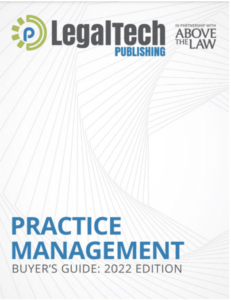
Pricing Legal Services as Your Firm Grows and Expands
Since the beginning of the 21st century, law firm pricing has evolved significantly. Clients demanded alternatives to the billable hour, and firms responded by introducing new pricing models for their existing services, including fixed fee structures, capped fees, partial contingency arrangements and fixed monthly budgets, among others. Pricing firm services, which was never a simple task, became even more complicated.
How to price your law firm’s value-added services
When a firm decides to introduce new services, it must consider whether to continue offering its existing billing models or take the opportunity to introduce new pricing. Firms can use new pricing models to accomplish a number of goals, from developing new clients to improving the firm’s financial performance profitability.
But when a firm decides to adopt new pricing, how does it determine what range of prices is reasonable and then optimize pricing within that range to maximize profitability?
Different law firm pricing strategies
The legal industry is exceedingly competitive and has become increasingly so in recent years. Clients unhappy with billable rate escalation demand that firms freeze or reduce rates or shift to alternative billing structures. Firms frequently offer loss leader pricing (i.e., pricing well below the competition) to bring clients in, then upsell them for future work. So, setting prices can be just as complicated as your firm’s legal work, and it requires equally diligent analysis.
Three fundamental pricing theories dominate the legal market:
- Cost/profit model: Firms set pricing to recover costs, plus an added percentage for profit.
- Competitive model: Firms set pricing based on the known or estimated pricing of their primary competitors.
- Value model: Pricing ties closely to the value you are providing the client.
Law firms have traditionally relied on the profit and competition models in the past, but more are transitioning to value pricing. This ties in with an overall shift towards client-centeredness.
One challenge firms face when pricing legal services is balancing price versus quality. Firms should never price their work at a point where they cannot offer the highest quality service to their clients.
“It can be tempting to compete for clients by setting prices lower than other firms, without regard to what is actually required to competently complete the work,” says Marcus Thymian, a founding partner of Chicago-based GrowIP Law Group. “But doing so can entice subpar work product, which is never a good idea. Besides inviting potential malpractice risk, sacrificing quality to offer below-market pricing could have long-lasting effects in client expectations, both in pricing and work quality.”
Indeed, price is only one factor clients consider when selecting a firm. Reputation, geographic location, and client relationships with individual attorneys also factor into a client’s decision. Law firms, therefore, must determine how much emphasis to put on pricing when marketing their services.
 Practice management tools make it easy to determine which case types and services are the most profitable for your firm. Download the free, LegalTech Practice Management Buyer’s Guide today.
Practice management tools make it easy to determine which case types and services are the most profitable for your firm. Download the free, LegalTech Practice Management Buyer’s Guide today.
Looking back: Review the effectiveness of your existing pricing
Before deciding on how to price new services, you should determine how effective your current pricing is. If an existing pricing scheme is profitable, there may be no need to change it. But how profitable is your pricing? You need to determine if you are missing opportunities to improve profitability with new pricing models.
Are you currently calculating profitability solely for the entire firm, or do you analyze profitability on a client-by-client or matter-by-matter basis? Especially if you are using a variety of pricing models (e.g., flat fee for transactional work, capped fee for litigation, etc.), calculating overall firm profitability does little to help you analyze whether your existing pricing models make sense.
Looking forward: Use existing client data to develop new pricing models
When building pricing for new services, there are several questions you must answer to set the framework for your analysis:
- What is the scope of services you are offering? Think about the types of tasks involved, the number of attorneys and other staff you must employ, allocation of overhead, such as software to the services, and traditional firm efficiency for similar services (you should build write-offs, discounts and cut time into your pricing model).
- What are the typical demands and expectations of your clients? Will they be willing to pay more for added value, or is the service in question a commodity where clients simply seek the lowest price?
- What types of pricing have you used for similar services in the past?
- Do you have high-quality existing client or matter data from similar services that you can use as a comparison or baseline to set pricing?
Data analytics is a valuable tool firms should use when developing new pricing models.
Firms typically have gigabytes or terabytes of data at hand to help them analyze the best way to price new services. This is particularly true for firms that have undergone digital transformations and put integrated practice management tools and legal process management workflows in place.
Thymian’s firm uses data analytics to optimize services, improve costs, and gain an edge on the competition. “Data analytics can be a helpful tool in building pricing models,” he says. “First, as taught in Economics 101, a theoretical ‘perfect market’ requires perfect information, something data analytics gets us closer to. But second, there is no perfect market in the real world, so having better information than one’s competitors creates a competitive advantage.”
Even firms without practice management solutions can use the accounting and time-tracking system data as a baseline for new pricing models. However, the process will likely be more complicated and time-intensive, as the firm must consolidate data from multiple sources for its analysis. Those firms would do well to consider upgrading to a more fully functional practice management solution.
How to use your firm’s data to make better pricing decisions
To use your existing data effectively, you must first understand the quality of your data. For instance, if you are trying to set flat fees for the stages of a litigation, it is essential to have a good record of how you allocated time to each litigation stage in your prior cases. This requires having your attorneys rigorously assign their time to appropriate billing codes, such as those in the ABA Uniform Task-Based Management System.
If your attorneys have been diligent in assigning tasks, then you have a useful dataset for developing your stage-based litigation fee structures. If, on the other hand, your attorneys assigned time to broad categories, or worse yet, relied on general matters, your historical data will not be of sufficient quality to help you build a stage-based flat fee litigation pricing model.
With quality data in hand, you can build future pricing based on what has worked for you in the past. Moreover, you can use that data to analyze whether different price models might be more profitable moving forward.
AbacusNext, a leading provider of secure integrated practice management solutions for professional services, can help you build the data set you need for future pricing efforts, whether you are a large general practice firm or a smaller boutique.